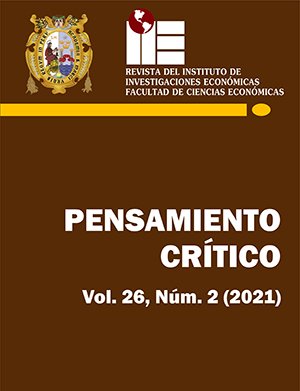Income from the oil canon and over canon and its socioeconomic effects. Case studies in Peru
DOI:
https://doi.org/10.15381/pc.v26i2.21601Keywords:
Oil canon and over-canon (OCOC), socioeconomic aspect, productivity, vector autoregressive (VAR), panel dataAbstract
The study identifies the effects of oil canon and over-canon income (OCOC) on two socioeconomic aspects: First, its contribution to GDP and productivity in the Loreto region. Second, to find the same contribution of the OCOC in the regions of Loreto, Piura, Tumbes, Huánuco and Ucayali in two dimensions: 1) the reduction of inequality, measured as the per capita expenditure among the poorest 40% of the population and, 2) decent work, measured as the percentage of young people between 15 and 24 years of age who do not study, do not work and do not receive training. The results showed that CSP had a positive but not significant impact on GDP and productivity in the Loreto region. The momentum is minimal. It represents a maximum of 9.5% of the fluctuations in the regional GDP and 0.13% in productivity. Regarding the second aspect, the effect is positive, significant and meager on the per capita expenditure of the poorest 40%. The effect on decent work among young people aged 15 and 24, according to the pooled data model, showed a statistical, positive and significant effect, and to that extent the income from the canon and over-canon did not promote improvement in this variable
Downloads
Published
Issue
Section
License
Copyright (c) 2021 Alexci Igor Chong Ríos, Luis Ángel Wong Valdiviezo, German Vladimir Chong Ríos

This work is licensed under a Creative Commons Attribution-NonCommercial-ShareAlike 4.0 International License.
THE AUTHORS RETAIN THEIR RIGHTS:
a. The authors retain their trademark and patent rights, and also on any process or procedure described in the article.
b. The authors retain the right to share, copy, distribute, execute and publicly communicate the article published in Pensamiento Crítico (for example, place it in an institutional repository or publish it in a book), with recognition of its initial publication in Pensamiento Crítico.
c. The authors retain the right to make a subsequent publication of their work, to use the article or any part of it (for example: a compilation of their works, notes for conferences, thesis, or for a book), provided they indicate the source of publication (authors of the work, journal, volume, number and date).






